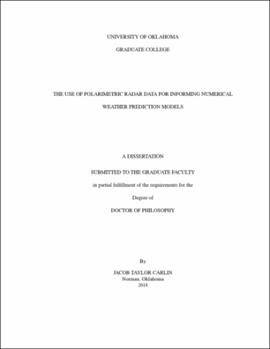| dc.description.abstract | The explicit prediction of convective storms using storm-scale models has recently become a reality. Radar data is a crucial source of information about the microphysical and kinematic properties of convection at the storm-scale. Whereas assimilation studies have primarily focused on radial velocity and reflectivity, much less has been done to investigate how dual-polarization radar data, and the enhanced microphysical information it offers, may inform storm-scale models.
This study employs a suite of microphysical and numerical weather prediction models, coupled to a polarimetric radar operator, to study how dual-polarization radar data may be used in conjunction with storm-scale models. The commonly-used polarimetric variables are defined, and a review of existing microphysical, wind, moisture, and thermodynamic retrieval and radar data assimilation techniques is presented for reflectivity, radial velocity, and dual-polarization data. Using a one-dimensional spectral bin model, the efficacy of reflectivity-based retrievals of hydrometeor mixing ratios in rain/hail mixtures, and the potential benefits of dual-polarization data, is assessed. A one-dimensional model of the melting layer is presented and used to study the impact of
the environment on polarimetric brightband characteristics, the potential for polarimetric thermodynamic retrievals in the melting layer, and the potential microphysical causes of “sagging” brightband signatures. Predicated on a connection between ZDR column characteristics and the latent heating rate within convective updrafts, a novel method for assimilating ZDR columns using a cloud analysis is developed, with results indicating positive impacts compared to reflectivity-based cloud analysis techniques. Future work ideas and an outlook for the near future is presented. | en_US |
